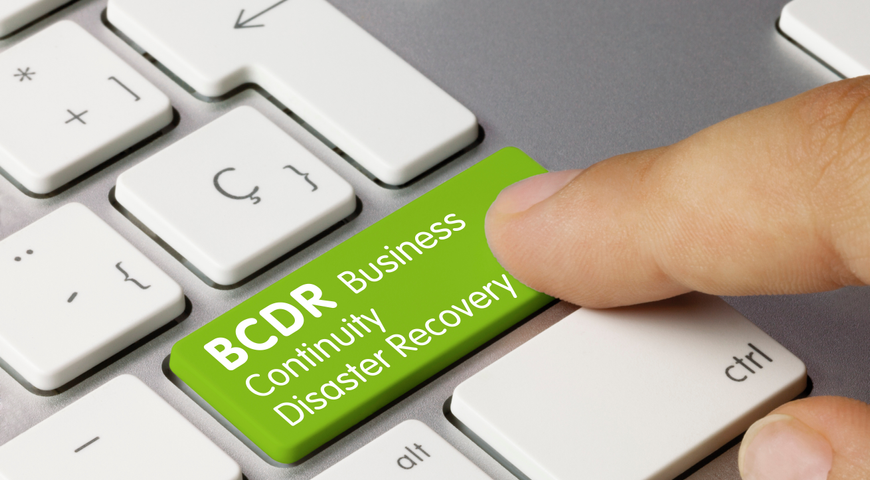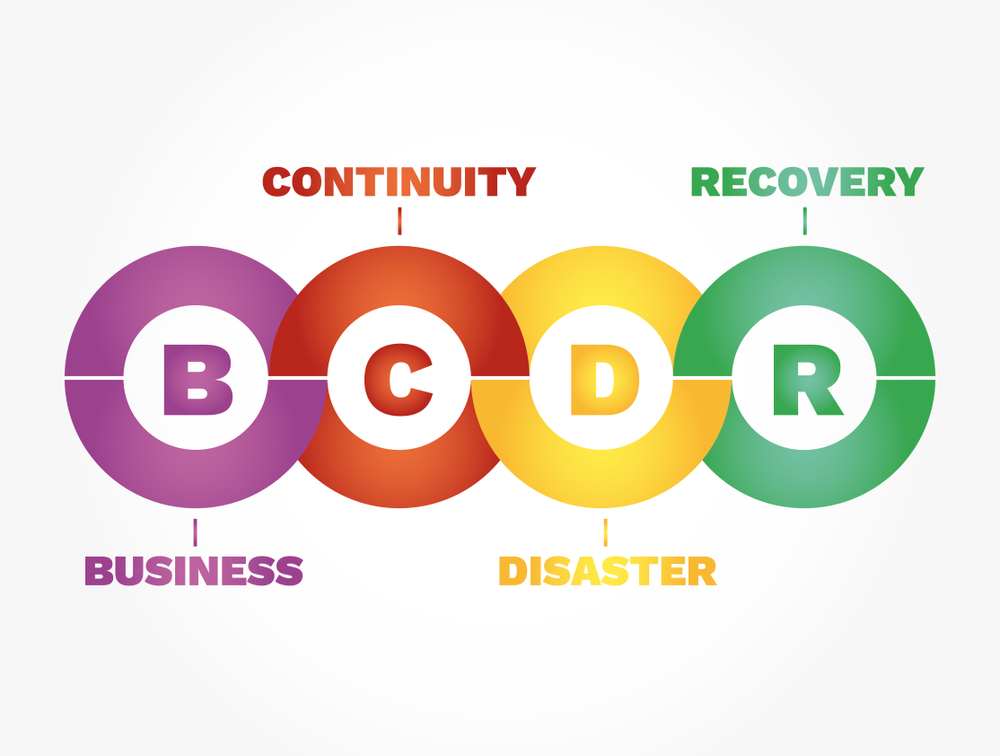
What is Business Continuity Disaster recovery plan?
A business continuity disaster recovery plan helps organizations and companies to prepare, for potentially harmful and disruptive events. It sums the ability to continue the business operations with no disruptions and minimizes the risk of unwanted interventions caused by human factor, or natural disaster.
BCDR uses a set of processes and techniques to help organizations to maintain normal business operations in case of unwanted threads or disaster scenario providing safe business processes, and securing the critical business functions of your organization. Business continuity disaster recovery plan gives the chance, for every company , or organization to adopt and bounce back from every single disruptive event, that may happen on a daily basis.
Despite the fact, that natural disasters can't be predicted you will feel the tranquility of having the best disaster preparedness no matter what happens, your business data, and critical business operations will be protected. Furthermore this will give you the opportunity of having business resilience on the highest level every single day, because it is well known fact, that a disaster strikes unexpectedly and it is totally unpredictable. You can remain calm and safe about your business when a data backup is used as a recovery process.
All these critical operations ensure business continuity for your business. For every self-respecting organization is a must to have a business continuity plans, and disaster recovery strategies in case of something unexpected happens. Business partners all over the world are looking for the best decisions of securing their organization's ability to backup in case of emergency. Does this sounds interesting and fundamental for your business too ? Let's have a closer look at what is BCDR, and dive deeper in the countless benefits it provides for you, and your business.
What does BCDR stand for?
Nowadays we live in a world where there must be zero tolerance, for a operational downtime, human error, natural disasters, or a cyber attack, because this can impact your critical business processes, which can be catastrophic event for your organization. Business continuity planning, and disaster recovery planning are the factors, that will minimize the impact of major disaster can have on a business ability to deliver it's products and services.

While both of them are very important even similar, they have important differences and understanding them is fundamental, for the security of your business. Nowadays business continuity and disaster recovery is the key factor to the success of dealing with variety of destructive scenarios. Where disaster planning and proactive strategies are the last peace of the puzzle, for having the best business continuity strategy. Proper crisis management is one of the most important things through the way of disaster recovery and stable business continuity management.
Every organization from the smallest to the largest depends on digital technologies to generate profit. So a proper BCDR approach is the key factor leading to success
What is BCDR?
Generally speaking BCDR professionals can help a business or organization to create a strategy how to survive when hard time comes. In every good and effective plan there must be a typical business continuity plan ,disaster recovery strategy and risk analysis. Guaranteeing the proper functioning of the normal operations and developing such a strategy is a complex process, that involves a business impact analysis and very good risk assessments, because of the times we live in there must be a clear plan to action, when the disaster occurs. An effective BCDR plan does not only restores your business data, but also minimizes the impact of eventual disruption on your business operations and gets your business on it's feet again in case of emergency management.
One of the worst things to happen to your business is downtime, because it really hurts your business, reputation and workflow and it really can ruin an entire organization and their organizational processes, in case of disaster and such events. The risk assessment is a crucial part of the good BCDR strategy and it should be directed to continual improvement day by day, because as we know there is always something to be done better. In this case a professional BCDR strategy is your important form of insurance for your business and technology infrastructure, and if your organization does not have a BCDR strategy it will be impossible to recover and resume operations normally when a disaster occurs. So it is very important for every small or large organization to have a recovery procedures and good business continuity for preventing any data loss.
What should you include in the BCDR plan?
As it is said there is no shortcut to happiness, and you have to have the best possible business continuity planning, recovery process and backup systems that assure your normal operation for your business. One thing is for sure every organization create it's structure and goals to achieve, which is why business continuity planning should be based on individual requirements and strategies. As we already know disaster recovery planning must be managed with different approach for every organization no matter how small or large it is, the business continuity management process must be at it's best to guarantee not a single data loss. Disaster recovery focuses on minimizing the risk of the impact of a disruptive event, and by this way an organization should equip for every possible disaster scenarios, that its business would encounter when the disaster strikes.
However, there are various specific areas that organization should focus on while they implement their efficient business continuity and disaster recovery plan. Risk assessment and business impact analysis are two of the most critical operations and stages in business continuity and disaster recovery plan can include. They are like the heart of the plan that business leaders should create for their company and once they are in place, it sets the stage for rapid recovery and data protection.
Risk assessment includes four vital disaster scenario that a business or organization can face and these are loss of access to promises, loss of data, loss of IT functions and loss of skills. These are the four major risk, despite the fact that there are other risks too. So the key role of the good business continuity and strategy can define processes ,qualify risks, and tackle them on time. This business continuity plan includes preventing the risks with high probability and high impact, accept the risks with low probability and low impact, contain the risks with high probability and low impact, and plan for the risks with low probability and high impact. Once these risks are defined, a business impact analysis can be done properly. You will be sure that your organization will survive when a disaster occurs, then you will know that you can rely that you will have your proper data recovery, data backup and the best business continuity management process.
Business impact analysis determines the relationship between different risks and factors. Each risk will be assessed for it's impact on business operations, financial performance and workflow. This will give you a complete picture of potential risks, probable cost, and the best recovery time objective, in case of potential disaster scenarios. It will determine the areas that require higher level of protection, the tolerance level for different disruptive events and the IT service levels needed for your organization.
What is the difference between a Disaster Recover Plan and a Business continuity planning?
Despite the fact that business continuity and a disaster recovery seem to be synonyms there are differences between them. Business continuity plan focuses more on proactive actions and generally refers to the processes and procedures every business must implement and ensuring that critical functions can continue during a disaster strikes and afterwards it has happened already. This area involves comprehensive planning in organizational processes geared through long-term challenges and organization's success.
On the other hand disaster recovery plan is more reactive and defines more specific steps an organization must take to resume operation and remain operational during and after a disaster. Disaster recovery involves taking place and actions after the accident, response and recovery times can range from seconds until days. In other words business continuity is focusing on the organization, and disaster recovery zeroes in on the technology infrastructure. It is a piece of business continuity plans are concentrated to accessing data easily. But it also includes risk management and planning for a organization to stay over the water during a disaster event.
It is true that continuity and disaster recovery have their similarities, they both consider different unplanned events like from human error, cyber attacks or a natural disasters. Their role is to guarantee the goal of getting the business running as close to normal as possible.
What are the 5 components of a business continuity plan?
We all know how important for every organization is to have a good continuity and disaster recovery plan. That means your business is more likely to keep it's critical business functions in times of disaster strikes or in any disruptive event. Natural disasters happen unexpectedly, and they are hard or almost impossible or be predicted.
So you really need to have your organization secured by the best business continuity management and disaster recovery plans. Having them will give you confidence and reduce recovery timescales and in this case, and in order to achieve this every business continuity plan needs to incorporate five key elements.
- Risk management and potential business impact it is based impact analysis, which identifies potential risks and vulnerabilities within and outside the business itself and choosing the right approach for the needed recovery strategies. These risks could be anything from a major IT disruptions to a something not so harmful but still is a risk like a failure from an important supplier.When knowing what could your organization potentially face in near future, you can take steps to prevent and minimize the risk. Good business continuity plans also use the output of your business impact analysis to reveal the possible damages and consequences of disruption your organization may face. This will open your eyes of what could you expect and what it will cost you, if this scenario happens.
- Planning an effective response, once you have awareness of the potential risks and threads your business may vulnerable to, you can begin forming your effective business continuity planning.A comprehensive business continuity plan will take each risk identified in the business impact analysis and generate appropriate approach of response for the secure business continuity of your organization. These detailed plans will describe the actions needed to be executed and outline who needs to be involved to implement it.
- Roles and responsibilities, in order for a crisis or disruptive event to be faced confidently, the key people in your team must know their roles and responsibilities. A business continuity plan will document which key personnel need to be involved in the disruption response. This typically is handled by a senior staff members, but it depends on your business and the type of risk you are dealing with.The resources and business continuity planning they already have should be clearly stated so they can be clarify what are they facing, and with what exactly they are dealing with.
- Another important aspect is the communication, which is key element in dealing with disaster events and following the best version of business continuity management. Because clear and effective communication is vital during business disruptions. The communication across your business can reassure team members and give them the needed confidence in the process of business continuity in an unexpected situation. So they will be able to take effective steps to respond and recover.To prepare for this, a business continuity plan will normally include a list of key contacts, having these in place can help communication and make it much easier in crisis and ensure that your staff and external contacts are kept up to speed.
- Testing and training is another key factor of keeping the best business continuity and disaster recovery. Business continuity plans are not just theoretical, but they also need to be trained enough to be put in action in a disaster recovery plan, so your organization to continue it's normal operations. In order to accomplish this, the final key and very important component of a business continuity plan is testing and training. Realistic scenarios can be simulated by the recovery personnel and recovery teams to test the plan in emergency situations and your team's response. By doing this, you can identify where is room for improvement and updates and take the necessary actions before a disruption occurs, you can really achieve this easily by having proper business continuity management system.Many companies run regular awareness training sessions about business continuity and disaster crisis, and keep it as a key component about dealing with them. It is proven that training and simulating these events improve the resilience of the company overall.
What are the 4 pillars of business continuity?
Your business runs on data. If you are unlucky enough to lose access and you have no disaster recovery plan, you immediately incur costs, productivity and customer dissatisfaction.
On the other hand if you have already prepared a business continuity plan and disaster recovery plan, then you feel confident about your organization recover and normal operation function. You need to provide these 4 hey pillars of business continuity.
- You have to protect your data at every level. Enterprise applications like MySQL, Exchange server and Hyper V-function their independent systems. They come with their user roles, access policies, and security features. All this data should be included in your backup plan. The complete data protection must cover file data, configuration data, application data and beyond.
- Backup your Backups. Most IT professionals are aware of the importance of this aspect, there is also a rule for the method 3-2-1 backup. Keep 3 copies of any important data that you can't afford to lose. The second one says that on-side you must use storage two mediums, for example hard drive and USB drive, NAS device and cloud server. The last rule of this strategy is that you must have 1 copy stored offsite.
- Store Backups in multiple locations. As we discussed above it is very important keeping your backups in different places. You should always keep one copy of your data on local NAS appliance, another at your backup site, and third in the cloud is a example of how you can be sure your data is always reliable and there won't be any problem in your disaster recovery plan.
- You must set logical recovery goals. When a disaster happens you want to rebound form a disaster as soon as possible. So you can help yourself with good disaster recovery planning and map out the road to recovery by setting specific recovering goals. Recovery point objective and recovery time objective are fundamental to business continuity planning. Despite the fact the names suggest, that they a similar, there are major differences parameters between them in the disaster recovery, that play equally important role in accomplishing the best disaster recovery plans. Recovery point objective refers to the maximum period of time in which data is not lost during a disruption. This parameter is vital in determining how often you need to backup your data. If you set RPO at eight hours to meet that objective you need to perform a backup at least once every eight hours to fulfill your disaster recovery plans. Recovery time objective refers to the target time designated to recover from an accident and keep your business continuity plan. In other words, this means how long an organization can afford to be inoperable before your business is negatively affected. For example if you set your recovery point objective at five hours, that means you will have five hours to get your servers, telecommunication or network services running. Used correctly RPO and RTO, both can provide a much better degree of measured guidance when responding to a disaster event.
How do you write a business continuity and disaster recovery plan?
Business continuity planning goes beyond the technology component. It combines and involves many short-term and long-term processes, such as the response, resumption, recovery, and the maintenance of the entire organization. There are eight major steps involved in creating a business continuity plan.
- Identifying the scope of the plan.
- Identifying key business areas.
- Identifying key critical function.
- Identifying dependencies between variety of business areas and functions.
- Determining acceptable downtime for each critical function.
- Testing your business continuity plan.
- Creating a plan to maintain operations.
- Reviewing and improving your business continuity plan.
Creating a Disaster Recovery Plan, which includes and contains a detailed instructions on how to respond to unexpected incidents and it is more thorough than a business continuity plan.
Here we have seven key steps in creating a disaster recovery plan.
- Creating a Disaster Recovery response team.
- Identifying critical operations and setting goals.
- Evaluating potential disaster scenarios.
- Having a communication plan.
- Establishing roles and different responsibilities.
- Developing a data backup and disaster recovery plans.
- Testing your plan, reviewing and updating your plan.
What are the 4 Ps of business continuity?
Business continuity planning is a crucial part of cyber security, but does your organization have a system that accounts for it's four phases ? The threat of data breaches leaks all over the organizations and a significant incident or a natural disaster can cause irreparable damage. This is exactly why every organization or business needs business continuity plan. It contains a set of processes that helps organizations respond to destructive incidents, cyber attacks caused by other third parties, or natural disasters.
When creating your business continuity strategy, you should consider the four phases which are :
- Initial responseThe first thing you have to do when discovering a disruption is work out of the seriousness of the damage, that has been made. What systems and locations are inaccessible? Is there any important information that has been compromised? As a proper response, your business continuity plan will include specific actions that will have to be taken in different scenarios, so all you need to do is align the damage with the appropriate approach and response.
- RelocationThe next necessary step is to move the affected files and areas out of the harm's way. As with the initial response, your business continuity plan should include specific details and actions based on each scenario.
- When you have already located and isolated the affected area, it is time to fix the problem. You can deal with some disruptions by yourself, but in most cases there is needed an expert help to overcome the problem and prevent any data loss.
- RestorationOnce the process of recovery has complete, your organization can return to business as usual. But first you will have to check and confirm that the recovery was successful, which is done by performing a test. If everything is fine with the test, you can move everything back to it's place.
What is the average cost of halt on business operations?
There is no lie about the fact, that downtime costs money, a lot of money for every organization, when something unexpected happens ,and your business can not operate properly. The cost is variable for every organization depending on the size and nature of every business as well the duration of downtime. As per latest surveys, which included respondents all across the globe, 30% reported that the average hourly downtime cost of their servers was between $310,000 and $400,000, and that is per hour. You can now imagine how devastating the duration of downtime can be, for these respondents.
As per another survey revealed that the average cost of an infrastructure failure is $110,000 per hour. Furthermore the average cost of unplanned application and server downtime per year ranges from $1.4 billion to $2.1 billion.
For the smaller companies reported the cost for downtime per hour was between $35,000 and $50,000, this leads to the conclusion that nobody is prepared when something unexpected occurs. And the only way to minimize the risks and the cost for your business is to have the best possible business continuity plan and disaster recovery plan. This is the only way to get easier through the hard times, the backup is lifesaving in this type of scenario.
How business continuity and disaster recovery are connected?
As we discussed above a disaster recovery plans act as a safeguard and protects your businesses from unpredicted circumstances. On the other hand business continuity plans aim at streamlining the processes after cause damage or disaster. It helps the implementations of a strategy that doesn't affect business activities and operations and ensures the smooth functioning within an organization. So the bond between the business continuity and disaster recovery is connected and one without the other would be impossible to execute the recovery of your business in case of unwanted and unexpected threats.
About Acronis
A Swiss company founded in Singapore in 2003, Acronis has 15 offices worldwide and employees in 50+ countries. Acronis Cyber Protect Cloud is available in 26 languages in 150 countries and is used by over 20,000 service providers to protect over 750,000 businesses.




